How One Community’s Action Project Is Teaching Students About Water, Trees, and Wildlife and How to Care for Them
By Sarah Newman and Carol Armstrong, Ph.D.
The Montgomery School, a private school in Chester County, Pennsylvania, for students in pre-kindergarten through eighth grade, has been the site of an EnviroDIY Monitoring Station along Pickering Creek since 2017. David Kline, a watershed education specialist at Stroud Water Research Center, was then a teacher at the school and facilitated its installation.
As a Penn State Extension Master Watershed Steward, I (Carol) have maintained the station since December 2017 for Green Valleys Watershed Association and the Stroud Center. Early on, I noticed the degrading vegetation along the stream’s banks. I also noticed there was very little bird call — only Carolina wrens and bluejays — and evidence of wildlife was scarce along this stretch of Pickering Creek, which lost its floodplain due to a 19th-century railroad and later, to Route 113 on one side and the school grounds on the other.
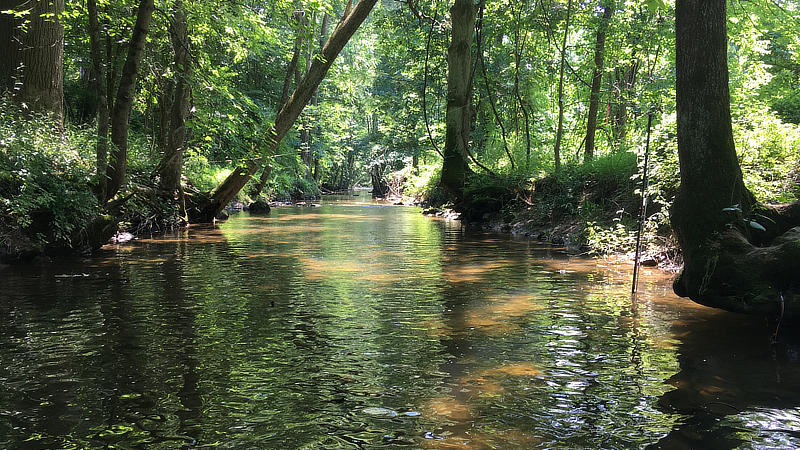
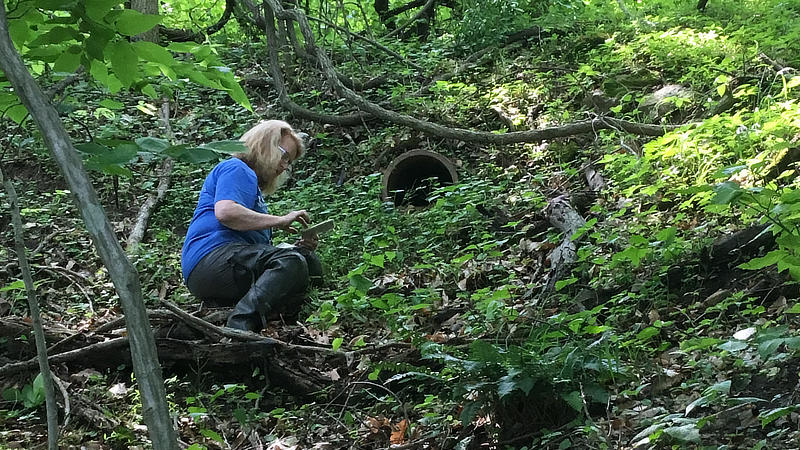
Flooding at the school became a chronic threat during heavy storms. The banks are steep, and the soils continue to erode, causing trees on the bank to fall, thus losing the streamside forest over time. It is a lovely place nonetheless, with a meandering path that is kept mowed, and an area along the stream where teachers bring students for outdoor learning.
Creating a Tree Planting Plan
Planting trees here would provide more nature lessons for the children, stabilize the banks, increase the plant and animal biodiversity, allow more stormwater to infiltrate, and bring more shade to a stream in which temperatures are often in the stress range for trout during mid-spring through mid-fall. The overall stream ecosystem would become healthier.
Like Carol, I (Sarah), am a Master Watershed Steward. I am also a member of the West Pikeland Environmental Advisory Council. In these roles, I have led planting projects in my own township, so Carol and I worked together with the school to plan and implement a streamside forest project along Pickering Creek.
As Master Watershed Stewards, we both educate people about the best ways they can protect water resources and get them involved in environmental stewardship. Our collaborative project with the school provided the students and teachers with an enriching educational and environmental stewardship experience.
When Carol contacted me (Sarah) about revitalizing the streamside forest at the school, I was excited to be a part of improving biodiversity and water quality. In 2022, I led two planting projects in Pine Creek Park, installing 425 trees and shrubs in mowed fields to support the eroding buffer of Pine Creek. That project taught me a lot about how vital partnerships can be, and I knew I could help. At the school, we needed to clear the area next to the stream of invasive plants, assess the various planting spaces for appropriate species placement, and figure out how the students and staff could integrate the planting work into their schedule and curriculum. Immediately, we got to work assessing the workload and creating a plan.
Outdoor Science Lessons that Teach Environmental Stewardship
Jacob Kratz, fifth- and sixth-grade science teacher, encourages environmental exploration and uses curriculum concepts of stream ecosystems in his class work. Every year, his classes raise and release rainbow trout into Pickering Creek. His students learn about the role streamside forests play in creating trout habitat.
Kratz says, “We frequently go down to the creek to see firsthand the concepts that we are covering in class. We continue to discuss the importance of the riparian buffer and the impact this project has downstream. Involving our campus in projects like this allows the students to investigate, explore, brainstorm, and solve real-world problems. They can observe the importance of reducing invasive species and replacing them with native species and the impact it has on wildlife. The students enjoy being outside and giving back to our planet.”
Beginning in May of 2022, we three surveyed the area near the creek for biodiversity and species of trees and shrubs. Certainly, the students would like planting, but clearing the invasive plants was important too. We marked several plots and assigned the number of trees and shrubs for each.
During the school’s Innovation Week in March of 2023, the students learned about the importance of a forested riparian zone for streams, and they prepared the planting sites and created project presentations to share with their fellow students.
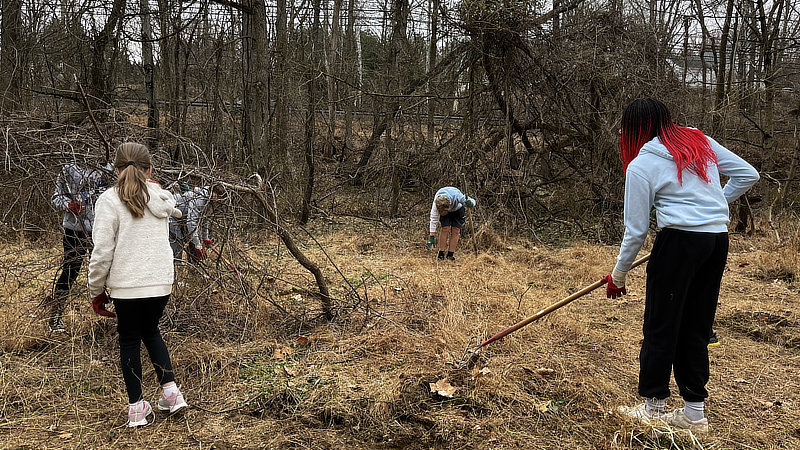
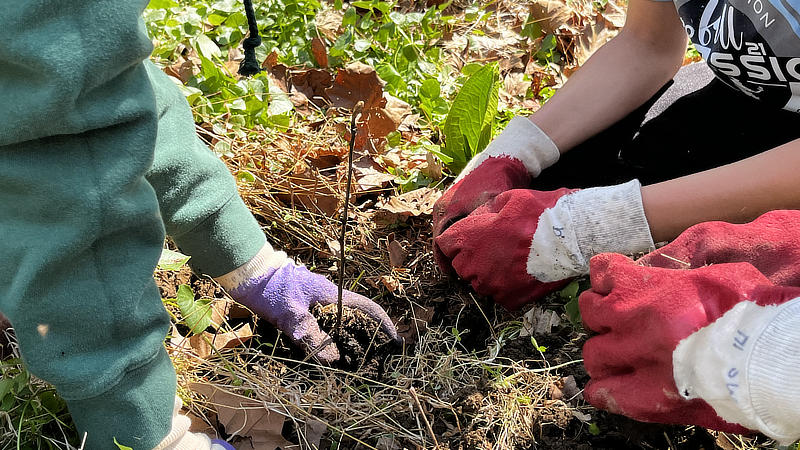
Finally, in April 2023, the planting took place during the students’ Earth Week. The Keystone 10 Million Trees Partnership provided grant funding for the trees and shrubs. The Chester County Conservation District tool trailer supplied tools for the students. The Montgomery School provided funding for coir mats and metal caging to group trees and protect shrubs.
Together, 80 students, three Master Watershed Stewards, and several school faculty worked to plant over 150 seedlings comprising 22 species, including shagbark hickory, five oak species, hawthorn, river birch, flowering dogwood, arrowwood viburnum, and winterberry. The resulting forest will continue to grow and protect the stream long after the students who planted them have graduated — a gift to the generations who follow them.
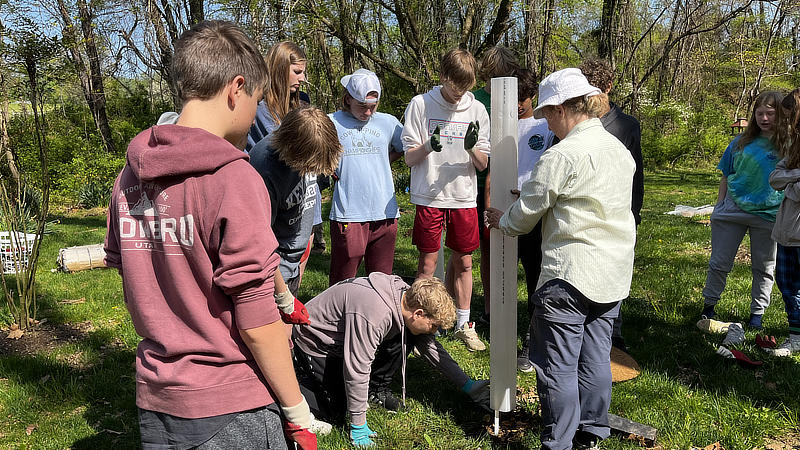

In October 2023, the new classes of fifth- and sixth-graders, who had not seen the project during planting, participated in a maintenance day. We replaced the trees that had died (fewer than 10%, thanks to the best practices we followed) and firmed up the stakes, cages, and tubes for the coming winter. The students learned how to plant a tree properly, what might have caused the deaths of some, and how to protect them.
It was a joy to work with these youth who had an instinctual connection to nature, a desire to see in action important concepts such as stormwater management and carbon sequestration that trees provide, and a desire to improve the earth as they move on in life. And it was a heck of a fun day in the woods by the stream!
Get Involved
Interested in monitoring water quality in your local area? Email us at communitysci@stroudcenter.org to become a community scientist today.



